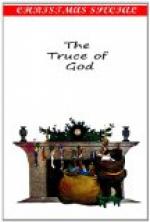Upon the slope of the hill, half-way between the castle and the lake, was a chapel built of white stone, which had stood there, according to tradition, from the ninth century. It was said to have been erected by Charlemagne, on his second expedition against the Saxons. The Baron of Hers had ornamented and repaired it with much taste and at great expense, until it was celebrated throughout the circle of Suabia for its richness and elegance. It had been dedicated to Mary the Morning Star, as appeared from a statue of the Blessed Virgin surmounted with a star, and was called the Pilgrim’s Chapel. It was in charge of Herman, a priest, who had studied at Monte Cassino under the Benedictines, with Father Omehr, whom he loved as a brother. They had spent their period of training and had been ordained together; and, for forty years they had labored in the same vineyard, side by side, yet seldom meeting. When they did meet, however, it was with the joy and chastened affection which only the pure-minded and truly religious can know; and they would recall with tears of happiness the scenes of other days—the splendid convent, whose church shone like a grotto of jewels and precious stones—the learned and devout monk, and the theological difficulties over which they had triumphed hand in hand.
After taking some slight refreshment (for the baron could ill brook a refusal of his cheer), Father Omehr left the father and son to each other, and began to descend the path to the chapel. Herman had gone to administer the last Sacraments to a distant parishioner. Father Omehr knelt down in the chapel and awaited his return. It did not seem long before his brother missionary entered through the sacristy and knelt beside him. The little chapel was very beautiful, with its branching pillars, supporting clusters of Angels carved in stone. The images of the Saints served to awaken many fine emotions—and the principal statue of Our Lady, which the artist had designed to represent the immaculate purity of the Mother of God—gave an indescribable sweetness to that consecrated spot: but more beautiful still, and more acceptable to God, were the two holy men who, bent with age and grown gray in the service of a heavenly Master, bowed down together before the altar of the Most High, and for a time forgot each other in the contemplation of the majesty and infinite goodness of Him they served.
At length they rose; and when in the open air gave way to the impulse of human love, which until then had yielded to a loftier feeling.
There was a room in the Castle of Hers in which Herman spent the hours not required for the active duties of his ministry, and to this the two friends retired. There for more than an hour, they discussed topics of mutual interest—compared the condition of their flocks—and wandered back to Naples and Monte Cassino. The introduction of this last subject seemed to remind Herman of something he had forgotten; for he started up and went to a shelf, which was filled with extracts he had been permitted to make from the celebrated library of the convent, and taking down a small piece of parchment, gave it to his companion. It was an illuminated manuscript of the Salve Regina.




